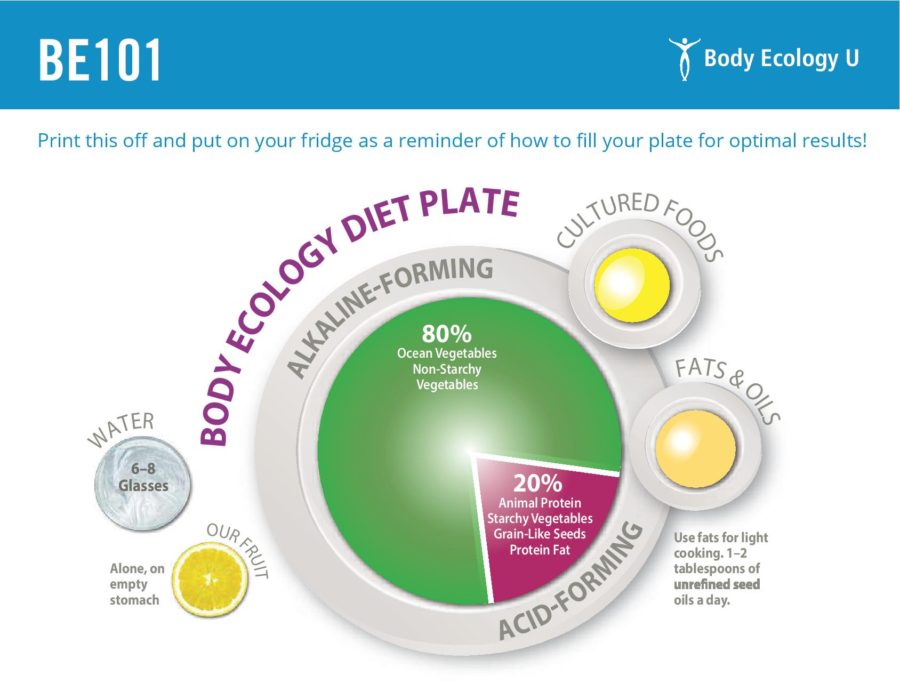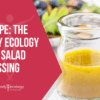The food combining diet: The Body Ecology principle of food combining
The purpose behind food combining is so straightforward that it can be easy to miss. Food combining is about improving your digestion, plain and simple. As Donna Gates, creator of The Body Ecology Diet, explains it, the health of your digestive tract is entirely dependent on the combination of the foods you eat at each meal. She says, “If you’re eating these complex meals that don’t go well together, [then] you’re putting this burden on your digestive tract to try to digest the foods that you eat.”

Food combining is an essential Body Ecology Principle to keep digestion running strong as the foundation of all good health. You can give your gut an extra boost to help break down food and improve nutrient absorption by taking Assist Full Spectrum digestive enzymes at each meal.
This digestive burden presents an even bigger dilemma when you consider the modern diet. We know that raw foods are naturally high in enzymes — for example, fruits and veggies contain their own plant enzymes that help to aid in digestion, as does raw dairy. But for the most part, critical enzymes in modern foods have been destroyed through processing, pasteurization, and packaging. This means that no matter how healthy and fresh you eat, you may not be digesting and absorbing all the nutrients your body needs without the help of food combining. Donna reminds us that the only thing more important than what you eat is how well you digest it.
What You Eat with What – It Matters!
Body Ecology is a gluten-free, sugar-free, anti-Candida diet, and the Principle of Food Combining is one of the main reasons why it works so well when other anti-Candida diets do not.
Proper food combining is essential to healthy digestion, and the violation of this principle has contributed to the weak digestion, imbalanced inner ecosystems, and overall ill health we see today.
A balanced inner ecosystem has plenty of friendly microflora (good bacteria) to help you digest the foods you eat and keep you healthy and strong. The introduction of processed and pasteurized foods, antibiotics, and other drugs and environmental toxins into our systems has destroyed the natural balance we were created to have. Our modern lifestyle has made conscientious planning and effort a requirement if we want to take care of our inner ecosystems and stay healthy. Learning and practicing the secrets of food combining is crucial for efficient digestion and better nutrient absorption, which leads to a leaner body, stronger immunity, and increased energy.
Why Food Combining Works
Different food groups prompt different enzymes to be secreted in your stomach, and each enzyme needs either an acid or alkaline environment in which to break down your food. Any chemistry student will tell you that when acids and bases (alkali) come into contact, they neutralize one another.
So what happens when you eat a food that requires an acidic environment to be broken down and absorbed together with a food that requires an alkaline environment?
You guessed it, your stomach essentially becomes a neutral zone — neither acid nor alkaline. This stalls the important work of the enzymes, which inhibits the whole digestive process. When this happens, your food sits in your stomach too long and begins to ferment and putrefy. Along with food combining, taking digestive enzymes with each meal can help to speed things along and reduce the likelihood of fermentation. It also helps to remember that there’s a distinct difference between food that ferments in the body and the fermented foods we recommend eating at each meal: Fermented foods, like cultured veggies and living probiotics, contain beneficial bacteria needed by the gut to support and improve health. “Rotting” food that ferments in the stomach can become toxic as it moves through the digestive tract.
Fermentation of food promotes alcohol and sugars to be produced. The yeast in your inner ecosystem happily feed off these sugars, multiplying and crowding out the beneficial microflora in your gut, which wreaks havoc on your health. If you already have weak digestion or a Candida imbalance, eating improperly combined meals further weakens your digestive tract until it slowly begins to break down.
By following the principles of proper food combining, you will begin to heal your digestive system and allow it to function as it was meant to. You will also experience these benefits:
- You will be less bloated after meals and notice that gas and stomach gurgling are no longer a concern. You may know people with hardy digestion who can handle meals that are not food combined properly, but they will often pay the price of digestive discomfort later.
- You will have a system to guide your choice of foods, which makes it easier to decide what to eat. You can use our handy food combining chart below to make your daily meal decisions both healthy and easy.
- You will no longer worry about your weight. If you are overweight, you will probably lose weight because properly combined food is well-assimilated and allows your body to metabolize food better, rather than store it as fat. Donna calls food combining her little weight loss “secret.”
- Easier and more efficient digestion means you will have more energy left over for living! Likewise, Donna considers food combining to be another secret to prevent us from aging so quickly. By using food combining to improve your body’s digestion and absorption of nutrients, Donna says, “We’re going to look different. We’re going to go through different decades, but it doesn’t mean we lose energy. It doesn’t mean our hair turns gray. It doesn’t mean our joints start wearing out, and things don’t work anymore.”
That said, it’s important for you to understand one overarching concept as we begin, a major DON’T that is often violated because you have always been told it’s okay.
NEVER eat an animal protein and a starchy vegetable or grain in the same meal:
- When you eat animal proteins like eggs, meat, poultry, or fish, your stomach produces hydrochloric acid and an enzyme called pepsin to digest them in the ideal, highly acidic conditions.
- When you eat a starchy vegetable, like yellow squash or one of the Body Ecology grain-like seeds, an enzyme called ptyalin is secreted, which develops an alkaline condition because that is what is ideal for these foods to digest properly.
Based on what we have already said about chemistry, can you see the problem?
Eating animal proteins and starches or grains together means acid and alkaline neutralize one another, enzymes can’t do their jobs, digestion stalls, and your food begins to ferment: This is feast time for the pathogenic bacteria and yeast like Candida that are in your digestive tract.
Think of the typical American fare: ham or turkey sandwich, steak and baked potato, pizza, burgers and fries. Your digestive tract has taken assault after assault, and the Standard American Diet (S.A.D.) makes it obvious why obesity and other illnesses are at epidemic levels.1 These diseases will continue to rise unless we start changing the way we think about the food on our plates. Sadly, the Western diet has already been proven to change gut bacteria and trigger the development of more serious gastric diseases, including colitis.2 Eating Western foods may even increase death risk after a prostate cancer diagnosis.3
Food Combining Rules Explained: The Body Ecology Principles Can’t Be Separated
All of the Body Ecology Principles work together in harmony to create balance in your inner ecosystem and propel you toward better health. You cannot practice one and ignore the others.
For example, the Principle of Food Combining explains why our 80/20 Principle states that 80 percent of the food on your plate should be composed of non-starchy land and/or sea vegetables and the other 20 percent should be animal protein OR grain — but never both.

To summarize, the two DOs are:
- It’s best to combine protein with non-starchy land and/or sea vegetables.
- It’s best to combine grains and starchy vegetables with non-starchy land and/or sea vegetables. Starchy vegetables are acorn or butternut squash, lima beans, artichokes, and red skin potatoes. (Red skin potatoes are the only potatoes we recommend because they have less sugar and don’t feed Candida yeast.)
Food combining lies at the foundation of the Body Ecology Diet because it brings us back to our ancient roots, promoting life-long health and vitality. Donna explains, “Because man didn’t have that rich array of foods, we wouldn’t have been able to eat that way a long time ago, and it’s part of the big mistake we’re making today.” She says, “It’s all about digestion and helping your digestive tract become healthier, so this is a valuable principle.”
What To Remember Most About This Article:
Do the foods that you eat together really matter? If you want to learn the best way to balance your inner ecosystem, it all starts with healthy digestion, made possible by proper food combining. This will make it easy for you to get all of the nutrients that you need right away to restore your body back to its natural balance.
You can help your digestion along by eating fermented foods each day, like cultured veggies and living probiotics, and by taking digestive enzymes at each meal. Sadly, most of our modern foods have been processed to the point that they are completely devoid of these natural digestive enzymes that we need to break down and assimilate food. That’s why food combining is so important — it makes it easier for your body to digest all the healthy foods you eat.
To practice basic food combining and to promote optimum health, we recommend that you enjoy protein with non-starchy land and/or sea vegetables and eat grains and starchy vegetables with non-starchy land and/or sea vegetables. It is not ideal to eat animal protein and a starchy vegetable/grain at the same meal. Making these simple changes may not only relieve what many consider “normal” digestive discomfort after a meal, but you may see dramatic improvements in your overall wellness, digestion, and energy.
REFERENCES:
- Asheley Cockrell Skinner, Eliana M. Perrin and Joseph A. Skelton. Prevalence of obesity and severe obesity in US children, 1999-2014. Obesity, April 2016 DOI: 10.1002/oby.21497.
- Suzanne Devkota, Yunwei Wang, Mark W. Musch, Vanessa Leone, Hannah Fehlner-Peach, Anuradha Nadimpalli, Dionysios A. Antonopoulos, Bana Jabri, Eugene B. Chang. Dietary-fat-induced taurocholic acid promotes pathobiont expansion and colitis in Il10−/− mice. Nature, 2012; DOI: 10.1038/nature11225.
- Meng Yang, Stacey A. Kenfield, Erin L. Van Blarigan, Julie L. Batista, Howard D. Sesso, Jing Ma, Meir J. Stampfer, and Jorge E. Chavarro. Dietary Patterns after Prostate Cancer Diagnosis in Relation to Disease-Specific and Total Mortality. Cancer Prevention Research, June 2015 DOI: 10.1158/1940-6207.








